Controlling slugs and snails – start NOW for summer success
How do you stop your plants from being eaten by slugs and snails?
Here on the Middlesized Garden, I often interview top professional gardeners to find out what really works for them. So here’s what they do to keep snails off their seedlings.
If you prefer seeing a video to reading a post, it’s here.
Start in early spring!
When I was first advised to start slug control in February, I was surprised. But that’s what the professionals do. Tom Brown is an award-winning garden writer and head gardener of West Dean Gardens in Sussex.
‘Two slugs in February quickly becomes 50 slugs in early summer. And then you can have 500 slugs before the end of the season. So start early with your beer traps or organic slug pellets.’
If, however, you are reading this later in the year, the methods below all work. Just remember to start earlier next year!
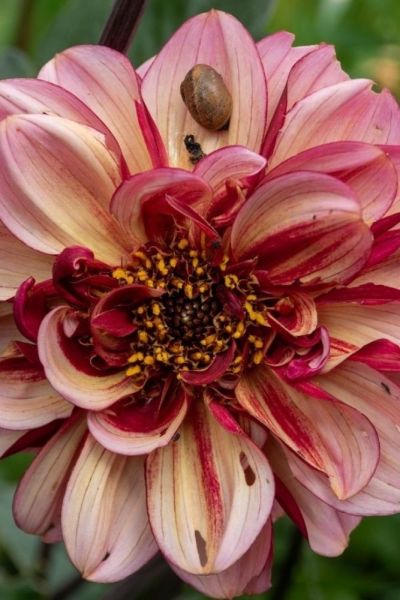
Dahlia ‘Senior’s Hope’ with some slug damage.
Read more of Tom’s advice for creating a stunning herbaceous border here.
What WON’T stop your slugs and snails…
First, the bad news. The Royal Horticultural Society in the UK has been trialling home remedies for controlling slugs and snails. These include using coffee grounds, egg shells, copper tape, pine bark mulch and sharp horticultural grit.
Researchers protected lettuces by surrounding them with a layer each of these. They then compared them to lettuces that weren’t protected in a 9 week study.
Unfortunately none of these remedies appeared to protect the lettuces from slugs and snails at all.
I appreciate that some of you have been using these methods for decades and that you do feel they work. So there may some factor at play that hasn’t been worked out yet. And the research is still ongoing.
But if you’re not already using these methods, you probably wouldn’t want to start. I have certainly seen snails clustering happily on a piece of copper, for example.
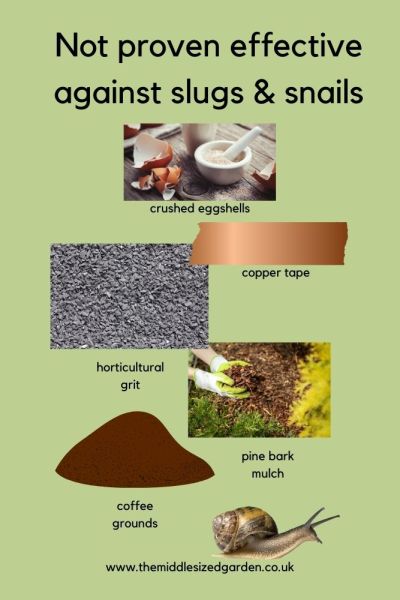
These popular methods of controlling slugs and snails don’t seem to work…but research is still ongoing.
Don’t try to get rid of slugs and snails completely…
Award winning head gardener and plant grower Steve Edney of the No Name Nursery says that you should not be thinking about eradicating slugs and snails. ‘Think about controlling them, and minimizing the damage they do.’
That’s his policy at the gardens he’s managed and also at the No Name Nursery. He has one of the longest perennial borders in the UK – 100 metres long. It’s absolutely stunning and is managed entirely without chemicals.
Slugs and snails have an important part to play in clearing up garden detritus. They are part of the ecosystem. They literally help keep your garden tidy by eating decaying plant material and fungi, as well as being a food source for birds and other animals. They mainly live on rotting leaves.
This approach is now echoed by the RHS who no longer classify snails and slugs as ‘pests’ because they have an environmental value in the garden, breaking down compost and rotting vegetation. See here for more about the RHS’s new approach to gardening with biodiversity in mind.
Alas – slugs and snails still can’t resist a row of newly planted seedlings…
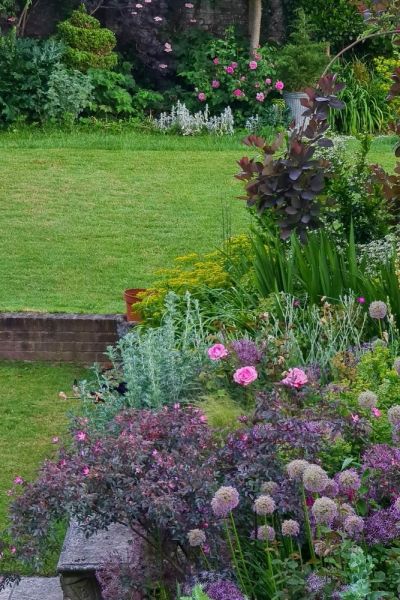
Slugs and snails play an important part in your garden – they live off rotting vegetation and funghi. It’s just a question of keeping them off your seedlings and dahlias.
So plant larger stronger plants…
For Jane Moore, head gardener at the Bath Priory Hotel and author of Planting for Butterflies and Planting for Wildlife, slug and snail precautions start when you’re planting.
She advises you to plant larger, stronger, healthier plants which can withstand slug damage. If you plant seedlings out immediately, then the slugs can eat the lot overnight.
Stephen Ryan of the Horti-Culturalists YouTube channel also has a nursery selling rare plants. Like the other professionals in this post, he can’t afford to lose plants to slugs and snails. He, too, keeps young plants and seedlings in pots until they’re large enough to plant out. He finds it most effective to keep those pots on shelves as slugs and snails won’t always climb.
He also thinks it works well to mix plants up. Read Stephen’s advice for combining slug resistant plants with vulnerable ones here.
Jane generally believes in a relaxed, easy approach to gardening, although the garden at the Bath Priory Hotel is absolutely stunning. Read Jane’s advice for gardening in autumn here.
Note: Links to Amazon are affiliate, see disclosure.
Water in the mornings only…
Water plants in the morning. Don’t accidentally replicate an environment that slugs and snails enjoy.
For example, head gardener Asa Gregors-Warg of the Beth Chatto Gardens says that they have relatively little slug and snail damage because they are in an exceptionally dry part of the UK.
Slugs and snails thrive in wet conditions and are most active at night. So watering your plants in the morning is a common sense way of making life a little more difficult for them. By evening the water will have been absorbed or will have evaporated.
‘Dry gardens’ or gravel gardens suffer very little damage from slugs and snails. If you live in a dry area and would like to try one, Asa explains how to make a dry garden here.
Slugs and snails love beer
BBC Gardeners World did a survey of its readers to find out which slug and snail control methods they found best.
The traditional beer trap was popular. You fill a small container with beer and bury it flush to the ground. Slugs are attracted to the beer and drown.
I don’t personally use this method as I am a little squeamish about disposing of the bodies every morning. But it is generally considered very effective, because you can see the slugs it kills.
You can buy purpose made slug and snail traps, such as those by Divchi. However, you can also just use a yogurt carton or something similar.
Pick out slugs and snails by hand at night with a torch
Many gardeners pick slugs and snails off their plants by hand or with tweezers. As the molluscs are most active by night, it’s best to go out then, with a torch.
However, the problem is what you do with the slugs and snails afterwards.
Traditionally, in London, you throw them over the wall to the neighbours. But slugs and snails travel surprisingly fast and they have a homing instinct. They will be back in your garden before breakfast.
I have read a suggestion that you should take them to the nearest wood to release them, which seems a little impractical for many of us.
I prefer to do my manual slug control by day. I turn over stones, bricks or pots to find places where they may be sheltering. This exposes them to the birds. It may only get rid of one or two slugs and snails a day. But that will save me 500 later in the year!
Grow plants that slugs and snails don’t like
Many of the plants at the Beth Chatto gardens, such as verbascum, don’t attract slugs and snails because they have hairy leaves.
Other good slug-resistant plants include day lilies, crocosmia, lavender, hydrangeas, salvia, thalictrum, poppies, roses, geraniums, Japanese anemomes and asters.
Look for plants with leathery, toxic or overly scented leaves which puts the slugs and snails off. This reads like a list of plants from my garden, so I have accidentally created a fairly mollusc resistant herbaceous border.
Use wildlife friendly slug pellets – very sparingly
Use wildlife friendly slug pellets with ferric phosphate. Do NOT use any with metaldehyde on the label as these can poison wildlife or pets.
Some people say that although organically approved slug pellets are pet and wildlife friendly, they can still leave damaging residues in the soil.
However, use them sparingly, just near the plants that are vulnerable to slug damage. You only need a few tiny blue pellets scattered near each vulnerable plant. Don’t pile them up.
In how to protect dahlias from earwigs, slugs and snails without using chemicals, Steve says that the soil should be damp when you use organic slug pellets. So if the weather has been dry, water the border first.
Tom Brown suggests putting just two or three tiny pellets under a roof tile or other place where slugs and snails will shelter.
Organically approve slug pellet brands I’ve used successfully include Richard Jacksons Flower Power Slug & Snail Control and Neodorff’s Sluggo.
Use nematodes – follow instructions exactly
Jane Moore uses nematodes at the Bath Priory Hotel, in the veg growing beds.
Nematodes have been scientifically proven to work against slugs and snails, especially as Jane explains, within a defined area, such as in raised vegetable beds.
But you do have to follow instructions accurately. They only work when the soil is at certain temperatures. Whether it’s been raining or not also affects it. So I did find nematodes a little complicated when I tried them.
If you’re good at following instructions, this is an effective method. But if your eyes glaze over the instructions on the packet, this method is probably not for you.
There’s a brand called Nemaslug in the UK.
Use sheep wool pellets or sheeps’ wool
The RHS also assessed sheep wool pellets as slug part of its study of barrier methods of slug control. They found that it wasn’t effective. However, gardeners I know have found this method effective, including Steve Edney.
Steve explains that you use sheeps’ wool pellets very differently from standard slug pellets. They don’t kill slugs and snails – it’s a barrier method.
So you have to use lots, so that they clump together and form a barrier. It will slowly decompose into the soil and will benefit the soil.
There are several brands, including Vitax Slug Gone and Defenders Slugs Away.
A wildlife friendly garden has fewer slugs
Many of the gardens I visit use the absolute minimum in terms of pest or disease control. They follow wildlife friendly policies, which mean that birds, frogs, toads and hedgehogs eat many of their slugs and snails.
But that doesn’t mean your garden has to look wild or untidy. Gardens that are open to the public have to look smart at all times, but they can still be wildlife friendly. At Hever Castle Gardens, head gardener Neil Miller only ever uses one spray (against blackspot). He relies on the birds to deal with other problems, such as aphids, slugs and snails.

The colonnade at Hever Castle Gardens. The gardens are managed in a wildlife friendly way and have virtually no slugs and snails.
Read Neil’s expert tips on growing roses here. And see his advice on choosing and growing tulips here.
Create a slug-free zone
You can’t get rid of slugs and snails completely from your garden. And neither is it a good idea to try, because of the benefits they also offer.
So one effective route is to combine all these methods into a slug-free area, where you can grow young plants and seedlings until they are big enough to withstand some nibbling.
For example, you might have a tray of young plants in a greenhouse, potting shed or on a terrace. You could protect them with organic slug pellets, which wouldn’t then be on the soil. Or you could use nematodes, sheeps wool or just keep picking them off.
If you also include lots of slug-resistant plants in your borders, you’ll then have a good display even if the slugs and snails do get a few.
Add in a wildlife friendly approach to gardening, and the birds will pick off some of your slugs and snails for you.
That’s what I’ve done, more or less by accident. And it works. I can’t remember the last time I lost an entire plant to slugs and snails. And you don’t notice a few lacy leaves when there are lots of other plants in the border.
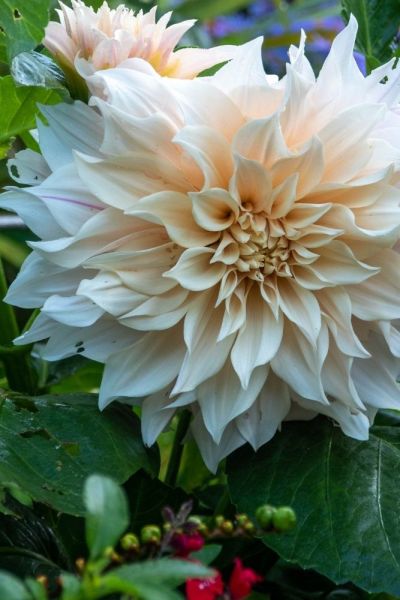
Let go of perfection. if you have a border full of beautiful flowers, you won’t notice a few nibbled leaves and petals. You have to go quite close to see that this Dahlia Cafe au Lait has some slug damage on the tips of the petals.
Pin to remember how to control slugs and snails
And do join us for a free weekly email with more tips, ideas and inspiration for your garden.
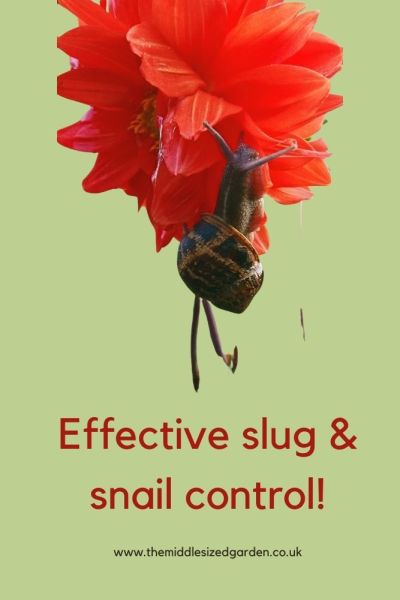
























I mulch with seaweed on my veg patch and I don’t seem so far
to have a snail/slug problem there…could it be the salt?
Hm, interesting, it might be. Must get some seaweed…
I’m afraid I go out at night with a sharp pair of scissors and deal with the slug population. The bodies are usually gone in the morning, slugs and snails are also cannibals!
Well done, I think I’m a bit too squeamish
Exactly what I’ve done in the past. Do one round then go out an hour later and the corpses will be covered with several other slugs which then get the same treatment. If you do this just once or twice on a balmy night you’ll really keep the population down though I actually over did it one time and felt so sickened and guilty that I’ve stopped the proctice….i
t really did level the balance out that’s for sure!!
It certainly sounds effective!
In my garden all snails get chucked into the field but they do have a homing instinct but for slugs, the garden media need to raise awareness of which slugs are ‘friendly’ and which are foe. Not all slugs feed on fresh material, some slugs are beneficial as they only feed on dead and decaying material.
Apparently it’s the little black ones that do the most damage and the big Orange/Brown Spanish slugs love Lupins so they gets chucked but any others I question whether they are good guys :-)
I agree. Have just found several of the little black ones…
I must have tried everything to deter slugs & snails (except the beer pots for the same reason). I don’t want to kill them, just protect the plants.
I came across Grazers Slug & Snail spray, which seemed to help. Still a few holes in hosta leaves, but a huge improvement. It’s iron based & makes the leaves distasteful.
That looks like an interesting product, I will try it, thank you.
Ive tried both methods from Grazers (spray and water). They do not work well. Picking snails and slugs at night is the best method for me.
Thank you for letting me know.
I have an old large and extremely heavy copper saucepan. Which is half filled with soil. When I find slugs and snails I put them on the soil and the birds eat them. I have never known a slug or snail venture to the sides of the pan in an attempt to escape. Maybe it’s the thickness of the copper….
Sounds like a good option!